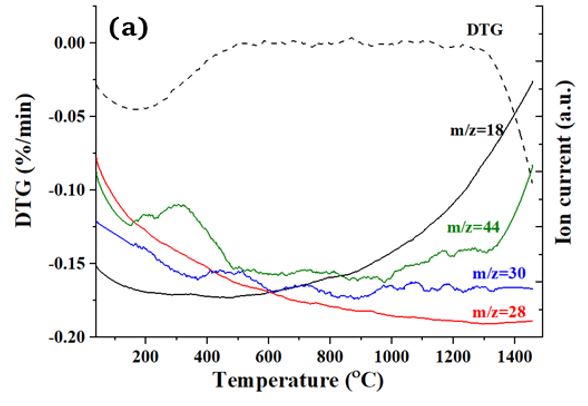
Synthesis of nanopowders by the glycine-nitrate method in the In-Dy-O system
Abstract
We investigated the feasibility of synthesizing nanopowders containing indium and dysprosium oxides by the glycine-nitrate method. It was found that the glycine-nitrate method significantly reduces the content of the indium component in the resulting mixture of indium and dysprosium oxides. In this case, intensive absorption of carbon dioxide from the air by the formed particles induces formation of amorphous carbonaceous compounds, which decompose only under high-temperature treatment (>900 °C). This prevents compaction of powders synthesized by the glycine-nitrate method. Comparison of the characteristics of powders containing indium oxides and dysprosium, synthesized by the glycine-nitrate method and by the method of co-precipitation of indium and dysprosium hydroxides from chloride solutions, showed the advantage of the co-precipitation method in the pressing of powders.
Keywords
Full Text:
PDFReferences
Li X, Qiu T, Zhao H, Yu H, Ma R. Application of rare earths in advanced ceramic materials. J Rare Earths. 2007;25:281–286. doi:10.1016/S1002-0721(07)60489-X
Anand K, Thangaraj R, Kohli N, Singh RC. Structural, optical and ethanol gas sensing properties of In2O3 and Dy3+:In2O3 nanoparticles. Solid State Physics AIP Conf Proc. 2014;1591:477–480. doi:10.1063/1.4872645
Dutta DP, Sudarsan V, Srinivasu P, Vinu A, Tyagi AK. Indium oxide and europium/dysprosium doped indium oxide nanoparticles: sonochemical synthesis, characterization, and photoluminescence studies. J Phys Chem C. 2008;112:6781–6785. doi:10.1021/jp800576y
Miao С, Chen С, Dai Q, Xu L, Song H. Dysprosium, holmium and erbium ions doped indium oxide nanotubes as photoanodes for dye sensitized solar cells and improved device performanceournal of colloid and interface. Sci. 2015;440:162–167. doi:10.1016/j.jcis.2014.10.055
Utsumi K, Takahara T, Kondo A, Matsunaga O, inventors; Tosoh Corp., assignee. Process of preparing high-density sintered ITO compact and sputtering target. United States patent US006033620 A. 2000 Mar 7.
Beer H, inventor; Magneto Chemie, assignee. Method of precipitating or co-precipitating metal oxides, metal hydroxides or metal salts. Canada Раtent СА 623339 A. 1961 Apr 7.
Yong XG, Ahalapitiya HJ, Zhen YX, Mingheng L. Hydrothermal synthesis of nanomaterials. J Nanomater. 2020;8917013. doi:10.1155/2020/8917013
Xu HR, Zhu GS, Zhou HY, Yu AB. Preparation of monodispersed tin-doped indium oxide powders by hydrothermal method. J Am Ceram Soc. 2005;88(4):986–988. doi:1111/j.1551-2916.2005.00158.x
Kessler VG, Seisenbaeva GA. Molecular mechanisms of the metal oxide sol-gel process and their application in approaches to thermodynamically challenging complex oxide materials. J Sol-Gel Sci Technol. 2023;107(1):1–11. doi:10.1007/s10971-023-06120-y
Du H, Castaing V, Guo D, Viana B. Rare-earths doped-nanoparticles prepared by pulsed laser ablation in liquids. Ceram Int. 2020;46(16B):26299–26308. doi:10.1016/j.ceramint.2020.04.291
Bazzi R, Flores-Gonzalez MA, Louis C, Lebbou K, Dujardin C, Brenier A, Zhang W, Tillement O, Bernstein E, Perriat P. Synthesis and luminescent properties of sub-5-nm lanthanide oxides nanoparticles. J Lumin. 2003;102(5):445–450. doi:10.1016/S0022-2313(02)00588-4
Hayashi T, Kawaratani K, Shimamura H, inventors; Mitsui Mining and Smelting Co. Ltd., assignee. Indium tin oxide fine powder and method for preparing the same. United States patent US006096285A, 2000 Aug. 1.
Malinovskaya TD, Ghyngazov SA, Zhek VV. Thermal destruction of coprecipitated hydroxides of indium and dysprosium. J Therm Analysis Calorimet. 2019;138:1871–1877. doi:10.1007/s10973-019-08261-1.13
Palmero P. Structural ceramic nanocomposites: a review of properties and powders’ synthesis methods. Nanomater. 2015;5:656–696. doi:10.3390/nano5020656
Patil KC, M.S. Hegde MC, T. Rattan T, Aruna ST. Chemistry of nanocrystalline oxide materials: combustion synthesis, properties and applications. New Jersey: World Scientific; 2008. 364 р. doi:10.1142/6754
Ostroushko AA, Russkikh OV. Oxide material synthesis by combustion of organic-inorganic compositions. Nanosystems Phys Chem Math. 2017;8(4):476–502. doi:10.17586/2220-8054-2017-8-4-476-502
Mukasyan AS, Martirosyan K. Combustion of heterogeneous systems: fundamentals and applications for material synthesis. Kerala, India: Transworld Research Network; 2007. 234 р.
Borisov AA, De Luca L, Merzhanov AG. Self-propagating high temperature synthesis of materials. New York: Taylor and Francis; 2002. 337 р.
Ozuna O, G A Hirata GA, McKittrick J. Pressure influenced combustion synthesis of γ- and α-Al2O3 nanocrystalline powders. J Phys Condens Matter. 2004;16:2585–2591. doi:10.1088/0953-8984/16/15/010
Varma A, Diakov V, Shafirovich E. Heterogeneous combustion: recent developments and new opportunities for chemical engineers. AIChE J. 2005;51:2876–2884. doi:10.1002/aic.10697
Mukasyan AS, Epstein P, Dinka P. Solution combustion synthesis of nanomaterials. Proc Comb Inst. 2007;31:1789–1795. doi:10.1016/J.PROCI.2006.07.052
Aruna ST, Mukasyan AS. Combustion synthesis and nanomaterials. Curr Opin Solid State Mater Sci. 2008; 12:44–50. doi:10.1016/j.cossms.2008.12.002
Mukasyan AS, Rogachev AS. Discrete reaction waves: gasless combustion of solid powder mixtures. Prog Energ Comb Sci. 2008;34:377–416. doi:10.1016/j.pecs.2007.09.002
Filimonov IA, Kidin NI. High-temperature combustion synthesis: generation of electromagnetic radiation and the effect of external electromagnetic fields. Comb Explos Shock Waves. 2005;41:639–656. doi:10.1007/s10573-005-0078-z
Ekambaram S, Patil KC, Maaza M. Synthesis of lamp phosphors: facile combustion approach. J Alloys Comp. 2005;393:81–92. doi:10.1016/j.jallcom.2004.10.015
Bachvarova-Nedelcheva A, Iordanova R, Stoyanova A, Gegova R, Dimitriev Y, Loukanov AR. Photocatalytic properties of ZnO/TiO2 powders obtained via combustion gel method. Cent Eur J Chem. 2013;11(3):364–370. doi:10.2478/s11532-012-0167-2
Kopp Alves A, Bergmann, CP, Berutti FA. Novel synthesis and characterization of nanostructured materials, engineering materials. Springer-Verlag Berlin Heidelberg. 2013;11–22. doi:10.1007/978-3-642-41275-2
Chick LA, Pederson LR, Maupin GD, Bates JL, Thomas LE, Exarhos GJ Glycine-nitrate combustion synthesis of oxide ceramic powders. Mater Lett.1990;10(1–2):6–12. doi:10.1016/0167-577X (90)90003-5
Wang H, Xu X, Li X, Zhang J, Li C. Synthesis and sintering of indium tin oxide nanoparticles by citrate-nitrate combustion method. Rare Metals. 2010;29(4):355–360. doi:10.1007/s12598-010-0129-9
Zelati A, Amirabadizadeh A, Kompany A, Salamati H, Sonier J. Manufacture and characterization of Dy2O3 nanoparticles via X-ray diffraction, TEM and photoluminescence. Ind J Sci Technol. 2013;6(12):5552–5558. doi:10.17485/ijst/2013/v6i12/43611
Zelati A, Amirabadizadeh A, Hosseini A. A facile approach to synthesize dysprosium oxide nanoparticles. Int J Ind Chem. 2014;5:69–75. doi:10.1007/s40090-014-0020-x
Zhukov AV, Min Thurein, Chizhevskaya SV, Merkushkin AO. The obtaining of zirconia nanopowders. Adv Chem Chem Technol. 2013;27(6):33–37. Russian. https://elibrary.ru/item.asp?id=20382880&ysclid=lk1ystdqrg595327219
DOI: https://doi.org/10.15826/chimtech.2023.10.3.03
Copyright (c) 2023 Tatiana D. Malinovskaya, Sergei A. Ghyngazov, Alexander I. Aparnev, Valentina V. Zhek

This work is licensed under a Creative Commons Attribution 4.0 International License.
Chimica Techno Acta, 2014–2025
eISSN 2411-1414
Copyright Notice







